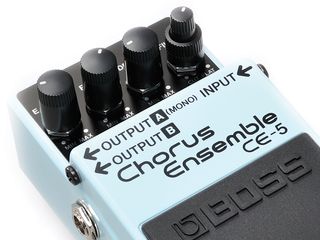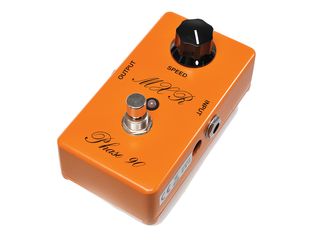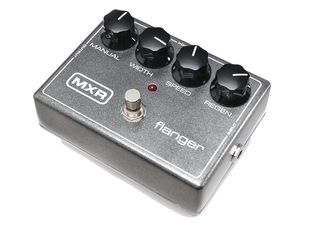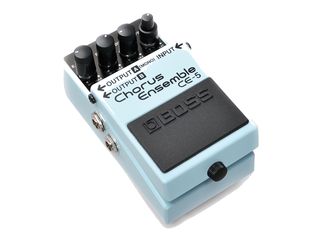The ultimate guide to guitar FX: modulation
Everything you ever needed to know about effects pedals

Modulation Pedals
Can't tell your phasers from your flangers? Want to understand the difference between a rotating speaker effect and a vibrato? Click through to find out everything you need to know about modulation effects...

Phaser
PHASER became a classic effect in 70s rock, used by everyone from the Eagles to Van Halen to add a swirling psychedelic edge to electric guitar sounds. To understand how phasers work, let’s remind ourselves of a little basic physics.
In their simplest form, soundwaves have regular peaks and troughs, like waves rolling towards a beach. Now imagine two identical soundwaves aligned so that when the one is peaking, the other is in a trough. These two soundwaves are said to be ‘out of phase’. In the most extreme out-of-phase alignments, they cancel each other out completely, resulting in silence.
Phaser pedals split your guitar’s signal into a dry half and a wet half that passes through multiple filters, knocking the two signals out of alignment. When the filtered (wet) signal is mixed with the dry signal again, phase interference occurs that creates cancelled-out gaps in your overall signal’s frequency range.
These gaps are then moved across the spectrum by a low-frequency oscillator (LFO, controlled by the rate knob). This constant movement morphs your guitar’s tone between bassy and warm, to toppy and brittle in regular cycles, creating the ‘swooshing’ sweep of a phaser effect.

Flanger
SONICALLY, flangers sound like the lovechild of chorus and phaser, adding a sinister metallic quality that makes them popular with metal bands such as, erm, Metallica.
As with chorus and phaser, the flanger generates its trademark sound by splitting the signal from your guitar into a dry uneffected half, and a wet signal that has a smidgen of delay. The delay times involved are shorter than in a chorus effect, with a typical duration of just a few milliseconds.
When the dry and delayed signals are blended together again, phase interference between them causes harmonically ordered gaps or ‘notches’ to appear in the frequency spectrum. The position of these notches is then swept up and down by a low-frequency oscillator (LFO, controlled by the rate knob) that alters the delay time of the wet signal – just like a phaser.
This produces the characteristic swirling sound. Flangers differ from phasers because the notches in the flanger signal are equally spaced across the frequency range.
Flangers produce a roiling, churning tone that is distinctively cold. Many flangers feed some of the blended output signal back into the input of the effect to add even more metallic, resonant overtones.

Chorus
KNOWN for the watery shimmer they add to electric guitar tone, chorus effects are designed to imitate the shimmer sound of a chorus of singers trying to pitch the same note.
Chorus effects split the signal from your guitar into a ‘dry’ half and a duplicate ‘wet’ signal that has a series of short delays and pitch variations applied to it. This wobbled- up signal is then blended back in with the dry signal. Discrepancies in pitch and timing between the wet and dry signals generates a ‘comb filter’ effect: a series of harmonically ordered notches in the frequency spectrum of your guitar tone that resembles the teeth of a comb.
This filtering effect alters with the varying pitch and delay times of the wet signal, controlled by the rate and depth knobs. Chorus pedals are available in both old-school analogue and modern digital varieties. Analogue versions usually sound a touch warmer than digital choruses, employing old-style ‘bucket-brigade’ delay chips to create shimmer and wobble.
Digital versions tend to be as crisp and clean as the crease in Pat Metheny’s slacks, and many, such as Boss’s popular CE-5 Chorus Ensemble, have highly tweakable features, such as stereo outputs and low- and high-pass filters.

Tremelo and vibrato
LET’S get one thing straight: that metal stick that you waggle to bend the pitch of your guitar strings? That’s not a tremolo. It’s a vibrato unit. But vibrato is also the name of a popular guitar effect, and both a picking-hand and fretting-hand playing technique.
Confused? So was Fender when in 1954 it christened the Stratocaster’s vibrato system the ‘Synchronized Tremolo’, and in 1956 when it launched the Vibrolux, an amp with a built-in tremolo circuit billed as offering onboard vibrato.
Although the terms have become interchangeable, they are separate effects and definitely not the same thing. Tremolo is a periodic variation in the volume or amplitude of your guitar’s signal. At its most dramatic, tremolo creates the kind of choppy stutter you can hear in Green Day’s Boulevard Of Broken Dreams and How Soon Is Now? by The Smiths, but more subtle flavours can lend a cool retro flavour to your sound.
Vibrato is a periodic variation in pitch. This can be achieved manually by waggling your whammy bar or moving your fingertip while you fret a note. Vibrato stompboxes tend to simulate the popular sound of a 1960s Leslie rotating speaker cabinet. Both pedals operate in a fairly similar way, with a rate control setting the speed that your volume/pitch throbs at, and depth control adjusting how much of your signal is being effected.

Total Guitar is Europe's best-selling guitar magazine.
Every month we feature interviews with the biggest names and hottest new acts in guitar land, plus Guest Lessons from the stars.
Finally, our Rocked & Rated section is the place to go for reviews, round-ups and help setting up your guitars and gear.
Subscribe: http://bit.ly/totalguitar

“This golden gain machine covers the entire spectrum from gritty boost through to full-on fuzz”: Great Eastern FX’s Focus Fuzz Deluxe has got boost, drive, octave, fuzz... everything going on

“This is the only tremolo pedal in the world that lets you plot your own waveform shapes using controls you first got to grips with as a child”: SoundLad Sketchy review

“This golden gain machine covers the entire spectrum from gritty boost through to full-on fuzz”: Great Eastern FX’s Focus Fuzz Deluxe has got boost, drive, octave, fuzz... everything going on

“This is the only tremolo pedal in the world that lets you plot your own waveform shapes using controls you first got to grips with as a child”: SoundLad Sketchy review










